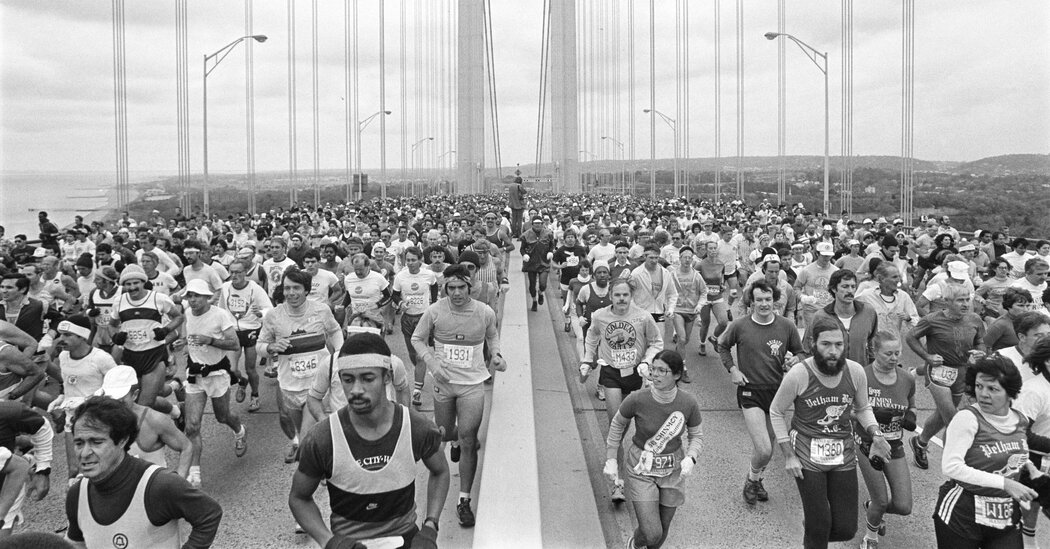
The New York City Marathon is one of the world’s largest road races and most democratic. Olympic medalists and world champions run the same 26.2 miles as weekend warriors. There have been 1,283,005 total finishers over 49 runnings, and thousands of photographs captured by scores of photographers for The New York Times.
The runners pulse through the five boroughs, and through the images here. Their thighs feel stabbingly sore, their hamstrings twang like banjos, and their toenails darken like the hastening afternoon sky. But the vast majority are triumphant in reaching the finish line, having challenged the limits of their endurance and experienced New York’s loud and welcoming and eccentric embrace. Where else can you expect to be high-fived by a cat?
Before the Race
Hours before the start, thousands of runners begin loading buses and ferries and travel from Manhattan to the start at Fort Wadsworth on Staten Island. They are extremely hydrated and nervous by this point, but there are lines of portable toilets available at the start and on the course. Unlike the annual international marathon in Pyongyang, North Korea, however, New York will not offer a chance to make an official pit stop in a karaoke bar.
And They’re Off
Frank Sinatra will sing “New York, New York” so many times as the waves of runners set off, even his recorded voice will begin to sound hoarse. This humpbacked start over the Verrazzano-Narrows Bridge is one of great expectancy, so the first mile uphill is hardly noticeable and the second mile downhill gives a giddy but treacherous sense of ease. The guy planning to dribble basketballs the entire 26.2 miles prays for little or no wind so his props don’t end up in the Atlantic Ocean.
Up Fourth Avenue
At this early stage in Brooklyn, this is less a race than a parade. The course is flat, the crowds are buoyant and the smell of Sunday morning cooking fills the air. Central Park, where the marathon was held in its entirety before it became a five-borough race in 1976, looks awfully far from here. But there is zero chance at this point that anyone is considering reaching the finish line in a cab.
Brooklyn to Queens
This is still mostly preamble. Bands are playing and signs in the crowd are funny: “Toenails are for losers.” “Pain is French for bread.” Then, on the Pulaski Bridge, you cross from Brooklyn into Queens and reach the halfway point at 13.1 miles. If you are a four-hour marathoner, you have reached midway as the men’s winner nears the finish line, about to complete 26.2 miles while averaging less than five minutes per mile. You wonder how someone can travel this fast while not riding a Vespa.
Into Manhattan
It begins to get serious, heading up the Queensboro Bridge at Mile 15. The race goes quiet on the bridge, with no cheering spectators and the sound of footsteps muffled by special race-day carpet. The Manhattan skyline comes into panoramic view, but runners are mostly turning inward, gauging their legs and their fuel. Soon, a spectator’s sign will inevitably warn: “This seems like an awful lot of work for a free banana.”
To the Bronx and Back
Exiting the bridge into Manhattan provides one of the most exhilarating and deceiving points on the course. The crowds swell along First Avenue and many runners make the mistake of speeding up recklessly, only to fade into exhaustion before the finish. Crowds thin in the Bronx, and back in Manhattan the legs grow heavy on the gradual uphill along Fifth Avenue. Fatigue can bring confusion. If a volunteer offers you something, make sure you are not about to eat a sponge.
The Finish Line
Those high-tech running shoes with catapults in the soles can only do so much. The final miles in Central Park are a grind. Two hills appear around Mile 24. After an excursion along 59th Street, runners re-enter the park at Columbus Circle for the final stretch. During the 1994 race, Germán Silva of Mexico turned prematurely into the park, recovered and still won. Do not try this.
Finally, a slight uphill leads to the finish line and, exhausted but satisfied, you get a medal around your neck. But you are not finished. You keep walking out of the park and join others making their way to their hotels, filling Midtown Manhattan with what seem to be spandex zombies in expensive shoes. Then you call home and report your time and say, “You won’t believe this, but I got high-fived by a cat.”


More Stories
Saudi Stable’s Triumphs Abroad: Fahd Al-Sayari’s Journey of Success in International Horse Racing
Watch: Ronaldo unveiled by Al Nassr
BCCI invites bids to operate women’s IPL teams